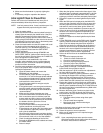
7800 SERIES RM7824A RELAY MODULE
65-0155—1
16
Initial Lightoff Check for Direct Spark
Ignition
This check applies for gas and oil burners that do not use a
pilot and it should immediately follow the preliminary
inspection. Refer to the appropriate sample block diagram of
field wiring for the ignition transformer and fuel valve(s)
hookup.
NOTE: Low pressure fuel limits, if used, could be open. If so,
bypass them with jumpers during this check.
1. Open the master switch.
2. Complete the normal checkout of the fuel supply and
equipment as recommended by the equipment
manufacturer.
3. Close all manual main fuel shutoff valve(s). Check that
the automatic fuel valve(s) are closed. Make sure fuel is
not entering the combustion chamber.
4. Close the master switch and start the system with a
call
for heat
by raising the setpoint of the operating
controller see Fig. 11 or RM7824A sequencing. The
primary sequence should start with the SAFE-START
sequence.
5. Let the sequence advance through STANDBY and
SAFE-START CHECK to Ignition Trial. Ignition spark
should occur. Listen for the click of the first stage fuel
solenoid valve(s).
6. Let the program sequence complete its cycle.
7. Open the manual fuel shutoff valve(s).
8. Push the reset pushbutton and recycle the program
sequence through STANDBY and SAFE-START
CHECK.
9. Watch for the FLAME LED to help determine when the
first stage burner flame is established. If it is
established, proceed to step 15.
10. If the first stage burner flame is not established within
four seconds, or within the normal lightoff time specified
by the equipment manufacturer, close the manual fuel
shutoff valve(s) and open the master switch.
11. Check all burner adjustments.
12. Wait about three minutes. Close the master switch,
open the manual fuel shutoff valve(s), and try again to
light off the burner. The first attempt may have been
required to purge the lines and bring sufficient fuel to
the burner.
13. If the first stage burner flame is not established within
four seconds, or within the normal lightoff time specified
by the equipment manufacturer, close the manual fuel
shutoff valve(s) and open the master switch.
14. If necessary, repeat steps 11 through 13 to establish
the first stage burner flame, then proceed to step 15.
15. When the first stage burner flame is established, the
sequence will advance to RUN. Make burner
adjustments for flame stability and input rating. If a
second stage is used, proceed to step 18.
16. Shut down the system by opening the burner switch or
by lowering the setpoint of the operating controller.
Make sure the burner flame goes out and make sure all
automatic fuel valve(s) close.
17. If used, remove the bypass jumpers from the low fuel
pressure limit and subbase.
18. If a second stage is used, make sure the automatic
second stage fuel valve(s) has opened, check the
lightoff as follows. Otherwise, proceed to step 19:
a. Open the manual second stage fuel valve(s).
b. Restart the system by raising the setpoint of the
operating controller.
c. When the first stage burner flame is established,
watch for the automatic second stage fuel
valve(s) to open. Observe that the second stage
lights off properly.
d. Make burner adjustments for flame stability and
input rating.
e. Shut down the system by lowering the setpoint of
the operating controller. Make sure the burner
flame goes out and all automatic fuel valve(s)
close.
19. Restart the system by closing the burner switch and/or
raising the setpoint of the operating controller. Observe
that the burner flame is established during PILOT
IGNITION, within the normal lightoff time specified by
the equipment manufacturer.
20. Measure the flame signal. Continue to check for the
proper signal, see Table 6, through the RUN period. Any
pulsating or unsteady readings will require further
attention.
21. Make sure all readings are within the required ranges
before proceeding.
NOTE: Upon completing these tests, open the master
switch and remove all test jumpers from the
subbase terminals, limits/controls or switches.
22. Return the system to normal operation.
Pilot Turndown Test (All Installations
Using a Pilot)
Perform this check on all installations that use a pilot. The
purpose of this test is to verify that the main burner can be lit
by the smallest pilot flame that will hold in the flame amplifier
and energize the FLAME LED. Clean the flame detector(s) to
make sure that it will detect the smallest acceptable pilot
flame. When using Self-checking Amplifier and 20K ohm/volt
voltmeter, the flame signal will fluctuate every time the
amplifier does a self-check or a shutter check.
NOTE: Low fuel pressure limits, if used, could be open. If so,
bypass them with jumpers during this test.
1. Open the master switch.
2. Close the main fuel shutoff valve(s).
3. Connect a manometer (or pressure gauge) to measure
pilot gas pressure during the turndown test.
4. Open the manual pilot shutoff valve(s).
5. Close the master switch and start the system with a
call
for heat
by raising the setpoint of the operating
controller. The primary sequence should start and
PILOT IGNITION should begin.
6. After the sequence has entered the normal burner run
period, very slowly turn the pilot gas pressure down,
reading the manometer (or pressure gauge) as the
pressure drops. Stop immediately when the FLAME
LED goes out. Note the pressure at this point.
NOTE: If there is not flame present for the selected
Flame Failure Response Test (FFRT), the
RM7824A will lock out.
a. Push the reset pushbutton and allow the
RM7824A to recycle to PILOT IGNITION.


















